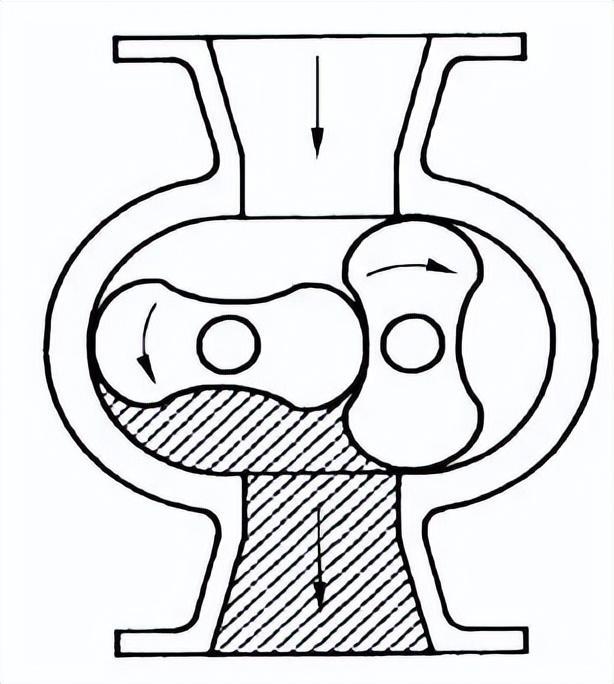




In the process of using Roots vacuum pump, some equipment such as refrigeration device and filtration device can be installed to ensure normal use of Roots vacuum pump. This not only improves the vacuum degree of the unit, but also extends its service life.
1. Install a multi-stage condenser in front of the unit
1) In order to minimize the volume of the unit as much as possible, a condenser can be installed before the gas enters the unit, so that the steam to be extracted condenses before entering the pump unit, leaving only non condensable gas and trace residual steam.
After the gas is cooled down, its volume also decreases at the same pressure, so the required pumping amount after condensation is reduced. Correspondingly, the pump can also be selected to be smaller. After cooling with steam, only non condensable gases remain.
When the pressure is very low, the specific volume of water vapor is quite large, and after these condensable vapors condense, the required pumping capacity of the pump is obviously greatly reduced.
In addition, regardless of whether the steam condenses or not, as long as the gas temperature decreases under the same pressure, its volumetric flow rate will decrease, thereby saving resources.
2) Although a first stage condenser was installed in front of the unit to prevent the majority of organic matter from entering the unit, according to the repair situation of the damaged Roots vacuum pump in the factory, a considerable part of the pump damage is due to the dirty rotor. After long-term use, the organic matter aggregates and sticks to the rotor, causing the rotor to jam and unable to start or with high resistance, causing the pump body to heat up significantly. This long-term operation damages the bearings and sealing components. During the maintenance process, the rotor must be thoroughly cleaned before it can continue to be used.
So, a second stage low-temperature condenser is installed after the first stage condenser to remove organic vapor that cannot be condensed by the first stage condenser, preventing organic matter from entering the pump chamber and avoiding organic matter sticking to the rotor and pump chamber.
After installing a secondary low-temperature condenser in the factory, the situation of Roots vacuum pump jamming has significantly decreased, indicating the necessity of installing a low-temperature condenser before gas enters the unit.

Before installation and use, the Roots vacuum pump should be carefully cleaned of welding slag and solid debris inside the pump and pipeline to prevent these debris from getting stuck in the rotor.
To achieve the ideal state of the Roots vacuum pump, attention should be paid to the configuration and installation of the suction and exhaust pipes. The diameter of the suction and exhaust pipes must meet the requirements of the Roots vacuum pump, and the pipe diameter used must be consistent with the size of the Roots vacuum pump housing, otherwise it will affect the normal operation of the Roots vacuum pump.
During pipeline installation, elbows and valves should be minimized as much as possible to reduce the resistance of extraction and exhaust, and to avoid reducing the vacuum degree and extraction volume due to the resistance of the pipeline.
A section of elastic hose must be installed in the connecting pipeline from the outlet of the Roots vacuum pump to the inlet of the front stage pump to reduce the impact of vibration from the front stage pump on the Roots vacuum pump.
In order to improve the ultimate vacuum degree of the Roots vacuum pump, it is necessary to correspondingly increase the ultimate vacuum degree of the front stage pump. Jet pumps and water ring pumps using water as the medium should try to reduce the water temperature as much as possible and increase the ultimate vacuum degree of the preceding pump.
After using Roots vacuum pump for a period of time, organic matter or scale will deposit on the surface of the rotor and pump chamber. When it reaches a certain thickness, it will change the gap between the rotors and reduce the heat transfer coefficient of the pump chamber, causing certain damage to various components, especially bearings.
At this point, it is possible to soak in approximately 5% acid-base solution and then rinse with plenty of water to remove any remaining acid-base to prevent corrosion.
The bearings and sealing components of Roots vacuum pumps require a certain amount of lubricating oil to work stably. During use, the lubricating oil is prone to oxidation and is easily emulsified by water that leaks into the system. In long-term continuous use, it must be replaced regularly, otherwise the bearing and mechanical sealing end face are easily damaged.
If the Roots vacuum pump is not used for a long time, it is easy to have a situation where it cannot rotate. On the one hand, the rotor clearance is damp and rusty, and on the other hand, impurities such as tar have stuck the rotor before stopping.
In general, if stopped, it should be regularly turned to prevent rusting and sticking of impurities such as coal tar.
If the rotor gets stuck, you can remove the back cover of the motor and use a tool to turn it around. After turning it around, you can start the Roots motor or suck in high-temperature steam while vacuuming the front stage pump. You can also rinse off the organic matter on the rotor.

+86 10-64730110
+86 10-64730100